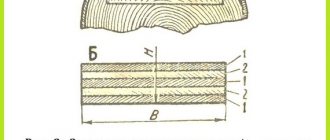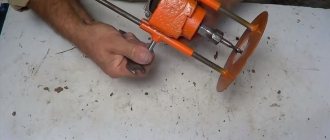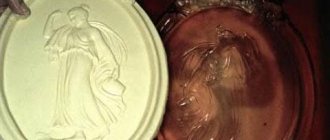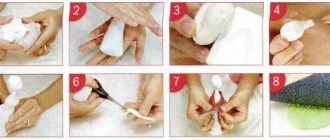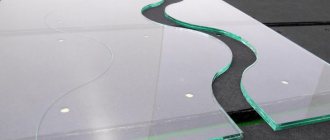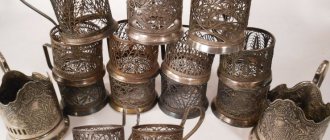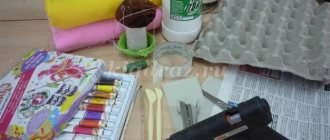DIY iron boat
IRON BOAT
An iron trough is clearly better than a wooden one. It is lighter, stronger, cheaper and does not leak. An iron boat is just as much better than a wooden one. It costs about 150 rubles, weighs 30 kg, is durable and does not allow water to pass through.
Buy 5 sheets of "four pound" roofing iron and combine them into one large sheet. Its size will be approximately 1,400 X 3,500 mm.
The best way to join iron sheets is butt welding, but you can also weld an overlay with an overlap of 4-5 mm or solder brass with an autogenous torch. You can also join the sheets with a double border, but each seam will take about 4 cm of sheet width and the boat will be shorter. It is easier to connect galvanized iron with a single bead and solder the seams with tin.
Exactly in the middle of the resulting large sheet, draw the center line “OO”. Trace the outline of the boat pattern (1) and mark the locations of the six holes on the center line.
Cut the sheet along the contour, punch the intended holes with a dia.
A. VODAR, engineer
meter 8.5 mm and a row of holes with a diameter of 2 mm along the sides and stern at a distance of 15 mm from the edge and 10-12 mm from one another.
Weld or flange the bow and stern corners, and the shell of the boat is ready. Cover it inside and out with drying oil.
Get 4 pine boards 20 mm thick and 4-4.5 m long, if possible without knots. Plan them and cut out two side beams (2), two bow beams (3), and a cross member (4). Nail down the shield (5), cut it to the shape of the stern of the shell so that its size is 1-2 mm smaller, and its height is 5 mm lower than the sides of the shell. Cut one board lengthwise and use it to make blanks for the outer and inner keels with a cross-section of 20 X 70 mm and a length of 2,000 mm (6). Cover all wooden parts with drying oil.
Insert the shield inside the shell of the boat with the flat side towards the stern, insert the inner keel, press it tightly against the shield and trace the outlines of the six holes in the shell.
Place the outer shell on the outside
Many of our readers built the boats described in the magazine “Technology for Youth” No. 4 for 1955 and in Ne 7 for 1956. However, we have received many letters complaining that in some areas it is difficult to obtain plywood for this purpose.
In this issue we publish an article by engineer A. Vodar, who made, in our opinion, a completely acceptable three-seater boat from roofing iron. On it he sailed many hundreds of kilometers along rivers and lakes.
The new keel is level with the stern and also outline the contours of the same holes. Then drill holes with a diameter of 8.5 mm in the keels and attach them to the body with M8 bolts and nuts (the nuts must be inside the shell). Place washers under the heads of the bolts and under the nuts - plates of roofing iron measuring 60 X 60 mm. Before assembly, lubricate the bolt threads with drying oil or grease.
Place the side beams into the shell, rest them against the stern panel and nail them to the sides, passing the nails through two-millimeter holes made in the hull. The side should protrude 5 mm above the side beam.
Place the bow frame into the shell, measure and cut off the excess side beams and nail the frame in the same way as the side beams. Bend the protruding edge of the bead and press it into the wood flush with the surface of the beams.
Under the junction of the bow frame and side beams, place pieces of boards about 400 mm long and nail them with nails, 3-4 pieces on each side. Attach 2-3 planks with the ends beveled to nothing on top of the bow frame. Then nail to them a deck cut from a sheet of roofing iron or plywood painted with hot varnish.
Mark the seating areas (bow, middle and stern), prepare 12 pieces of planks for the seats (section 15X70 mm, length 0.7-0.9 m) and 6 strips of iron (size 60X400 mm, thickness 0.5-0.8 mm ). Bend the strips lengthwise at right angles. Cut the boards so that their length matches the distance between the sides in the designated* places.
Attach the iron strips to the boards with screws (7). Then drill holes with a diameter of 6.5 mm in the sides of the boat and the vertical bends of the strips and fasten the strips to the sides with MB screws. Fasten the ends of the side beams to the stern board with squares.
Preparing to chisel a boat
Having installed the workpiece on the keel, using a plumb line we check the verticality of the lines at the ends. Then, looking from the ends, stepping back from the extreme vertical lines to the right and left by 20 mm, we beat off two horizontal lines along the length of the trunk. Using a string, measure the length of the arc along the sides and bottom of the boat. Now, dividing the resulting value by four (folding the lace in four), we put it away from the end of the nose bevel and make a mark. We measure the same distance, but reduced by 20–25 mm, from the bevel on the stern and also make a mark. We perform these operations on both sides (along the sides) of the workpiece.
We connect the resulting marks, as shown in the figure, and use an ax to select the part of the workpiece highlighted by hatching. To speed up the work, you can use a chainsaw or a two-handed crosscut saw, making preliminary cuts.
We cut the space between the points marked with the letters A and B with an ax in the form of a gutter, and towards the stern and bow the slope of the gutter walls increases from 90° to 120°.
Now you need to gradually “finish” the shape of the sides of the gutter, as well as the shape of the bottom. In addition, in the stern and bow it is necessary to narrow the upper part by 30–40 mm on both sides. From the points marked with the letters B, D, D, E, we beat off lines to the ends of the bow and stern and remove the excess with an ax. This concludes the preparation for chiseling.
DIY boat “Dolblenka” using old-fashioned technology
Dear visitors to the site “Visiting Samodelkin”, from the material presented you will learn how to make yourself a “Dugout” boat with your own hands. For which only natural material is used, namely soft wood, for example willow or aspen. The tree is selected in advance, straight and without branches, and the thickness of the trunk will be responsible for the displacement of the future vessel.
This technology for creating boats is very ancient and was passed down from generation to generation, from Father to Son, today it is almost forgotten, but there are still “Craftsmen - Well Done” on the Russian Land!
Let's look at what exactly the author will need to build a boat? We’ll also look at all the stages and watch the movie (Cut down your nerd).
Materials
1. softwood (willow, aspen)
Tools
1. chainsaw 2. hacksaw 3. ax 4. adze 5. jointer 6. fire source (blowtorch)
Master class from Ivan Petrovich Ovchinnikov on building a “Dolblenki” boat with your own hands
And so, the author adopted this technology from his Father, and he, in turn, from his parent). In ancient times in Rus', the main building material, as you know, was wood, and furniture, dishes, peasant implements, carts, etc. were also made.
Boats and longships, respectively, were also built from wood; entire artels and brigades were created for this purpose. It may seem strange. but they began to make boats in the winter, when the tree is still asleep. The most suitable tree (aspen) was selected in the forest, cut down and shaped into a boat, after which the workpiece was covered with snow and remained in this position until early spring. During this time, the tree absorbed moisture properly. Why leave the boat in the forest, and even in the snow. The fact is that for the further process of forming the boat, it is necessary to dry it over an open fire, place spacers, thereby giving it its final shape (everything is described in detail in the film)
But D. Vanya took a slightly different, easier path, chose a large and thick one (willow) in advance, cut it down to the very root, removed the bark and began to form the boat.
Our author got such a wonderful boat; now he can sail along the Don and fish. As you can see, it was quite easy for the craftsman to cut down the boat, and the most important thing is that the material is free and given by nature itself.
You can also watch a very good film about the production of “Dugout” boats using ancient technology.
This concludes the article. Thank you for your attention! Come visit often, don't miss out on new items in the world of homemade products!
The article is presented for informational purposes only! Source
Receive a selection of new homemade products by email. No spam, only useful ideas!
*By filling out the form you agree to the processing of personal data
Dugout boat - we make it ourselves, a boat hollowed out of wood.For its simplicity and functionality, the dugout boat
fell in love with our ancestors, long before the New Era, approximately 11th century BC.
These hollowed-out boats made from solid wood also gained popularity among the ancient Greeks and many peoples of the world who inhabited our planet at that time. Therefore, it would not be entirely fair not to give them due attention in the “Home Shipyard”
, and not to publish an article on
making a dugout boat yourself.
It should be noted that for many decades the secrets of boat masters were passed on “by word of mouth”, from father to son, without drawings or calculations. And since a limited number of people were engaged in this trade, today it is very difficult to find a specialist who can competently, according to all the rules, make a real dugout. This is aggravated by the fact that now, in the era of modern materials and technologies, there are practically no masters of the younger generation, and the old ones, unfortunately, take their experience and skill with them: their art dies with them. That's why we decided to introduce home-made people to the process of making a dugout boat. Perhaps some of them will be interested in this topic. We hope that the traditions of folk crafts will be preserved and continue with their help, bringing benefits.
When describing the procedure for working on a boat, we proceed from the capabilities of a single craftsman, without the use of machine tools or any lifting mechanisms. However, in any case, both the manufacturing process and the boat itself will bring you real pleasure.
General recommendations for building a dugout boat
When getting started, there are a few things to keep in mind:
1. Don’t start making a big boat right away.
An unprepared person may not be able to do this. It would be more correct to try a version 3–4 meters long. 2. Do not neglect the recommendations regarding the choice of material, size, and time of cutting wood. They are dictated not by our whim, but by many years of observations of more than one generation. This is exactly what our great-grandfathers advised. 3. The proposed technology and terminology takes place in our places, in the Krasnoyarsk Territory. Of course, it may differ in other areas. Keep this in mind to avoid confusion. 4. Don’t forget about the accumulated experience in amateur shipbuilding. Various additional literature is very useful for work, especially if a beginner takes it on. A dugout boat can be made directly on the river bank.
In the photo is the oldest master boatmaker Yakov Evmenovich Solomennikov. Selection of material and dimensions of the dugout boat
A homemade solid wood boat can be made from pine, cedar, larch, aspen or poplar. In our area, preference is given to aspen and poplar, as their wood is durable and easy to process. The time of year for cutting down a tree does not matter much; it can be both winter and summer. It is important that this is done on the full moon. According to the experience of old craftsmen, if you cut down a tree “for the new month”, then the manufactured boat will be very difficult to build, and during operation it will quickly fail. This may seem like prejudice to some, but this advice has come to us from antiquity.
The length of the boat is selected based on the required load capacity (usually about half a ton), the condition of the body of water where it will be used, and the availability of suitable size wood. The following dimensions are usually used: 4.5 m, 7 m and 9 m. The longer the boat, the more labor-intensive it is, naturally, to manufacture, but it runs better. The appropriate diameter of the trunk is selected as follows: clasp the tree with both hands, and if the fingers do not meet by 30–40 cm, this is what you need (circumference length is approximately 180–200 cm).
Tools needed to make a dugout boat
To make a boat you will need the following tools: an ax; adze - straight and side (made from an ax with subsequent hardening); plumb line; a brace or drill with a drill with a diameter of 10 mm; a two-handed plane (a regular one-handed one will also work, but it’s more difficult to work with); crosscut saw or chainsaw.
Preparing the bottom of a dugout boat
Having laid the felled trunk of the selected dimensions on two thick poles (this will make it more convenient to work alone), they begin to prepare the bottom of the future boat. To do this, inspect the workpiece along its length and find a section that is flat along its entire length, without visible dips or curvatures in the middle - this will be the bottom. The selected area is sanded with a width slightly larger than the width of the ax blade, and then a line is struck on the resulting strip using a plumb line and a cord. Now we carefully remove the layer of wood along the line, making sure that there are no humps or depressions.
Beginning of work. Breaking out the marking line.
Having turned the trunk over on the poles and secured it so that the bottom plane is horizontal, we determine the middle of the log. For this, a plumb line and a ruler are used. Having broken through the middle with a lace, we step back to the right and left of this line by about 40–45 mm (two fingers) and draw two more side lines.
Determining the center line, processing and marking the bottom of the boat.
Preparing the bow and stern of the boat
When starting to mark the bow and stern, you need to remember that the butt of the workpiece will be the bow of the boat, and the top will be the stern, that is, the bow should be larger in size than the stern. This factor is associated with operating features, for example, with outboard motors.
After completing all of the above, from the bow and stern, along a plumb line, we beat off lines that are, as it were, a continuation of the middle and lateral lines of the bottom. Stepping back from the bottom edge of the log by 120–150 mm, we draw the lower edges of the bow and stern perpendicular to the vertical lines.
Marking the ends of the workpiece.
Now we need to determine the lengths of the bow and stern. When making a boat of recommended dimensions, they are approximately 500–600 mm and 400–500 mm, respectively. In general, they depend on the diameter of the trunk and can change in one direction or another. But for any value, the length of the bow should be 100–120 mm greater than the length of the stern. In order not to subsequently “lose” the necessary points (the intersections of the lower edge lines with vertical markings at the ends and the side lines of horizontal markings with limiters for the length of the stern and bow), highlight them with a bright pencil or charcoal.
Determining the length of the bow and stern of the boat. Selecting reference points.
The cutting of the bow and stern is done with an ax. Here it is important not to rush and not to cut beyond the marked points. The slope of the cheeks should not be too steep and not too gentle. Any other recommendations are hardly appropriate: you just need to feel the tree and, when choosing sizes, rely first on intuition, and then on experience. So, with a sharply sharpened ax we give the cheek the shape shown in the figure. We process the workpiece on the other side in the same way. Then we connect the reference points and remove the excess so that we get a narrow inclined surface.
Processing of the extremities: A - formation of the cheeks, B - processing of the stem.
Having processed both ends in the described way and without turning the workpiece over, sand it over the entire visible surface. From the outermost horizontal marking lines, we remove the wood with tapes so that the cross-section of the trunk takes on an egg-shaped shape. This usually requires going through 4-5 tapes. Of course, we must not forget about the symmetry of the sides, and also avoid visible dips and bulges. The exit of the tape to the nose and norm should be smooth. This work is not difficult, but it requires accuracy and should not be rushed. Finally, turn the workpiece over and finally sand it. Y. Solomennikov, I. Solomennikov, p. Karatuz, Krasnoyarsk region.
Pan-As website, homemade crafts website - the website has everything you can do with your own hands: crafts, handicrafts, jewelry, children's crafts. Make them yourself, with your own hands, and get real pleasure from it.
Related materials:
| Steamboat origami paper diagram | |
| Paper model “Statue of Liberty” |
| Growing radishes in winter. Technology, selection of varieties, care. |
| Paper pistol. DIY gift for February 23 |
| Paper model “Bates_House” (Adams house) |
Preparation
The prepared wood is brought into a dry room and laid on a flat surface. Then a small weight is placed on top to avoid distortions. The board will remain in this position for a year.
Boat hull sheathing with sheet metal
After waiting the allotted time to prepare the material when building the boat, we proceed to the following stages of preparation:
- We measure the length of the sides, leaving a small margin, and file them down, maintaining an angle of 45 degrees. The location of the cut will be the bow of the boat. Next, take a plane and plan the board along the entire length on both sides; chamfer is removed at the cut points in order to fit the parts tightly to each other. After the preparatory work, it is necessary to cover all cut areas with an antiseptic.
- Next, you need to make a triangular block to fasten the bow of the vessel. The length of the workpiece should be one and a half times the width of the side. The block is planed and coated with an antiseptic.
- To make the back part, you will need a wider board, preferably fifty. Don't forget about small reserves after sawing.
Frame assembly process
After preparing all the parts for the boat, we begin the actual process of assembling the boat from galvanized sheets and boards with our own hands. To do this you need to do the following:
- In the bow, it is necessary to combine two sides and a triangular blank for the bow. Nails or screws can be used as connecting elements. If the block protrudes above the sides, then it needs to be sawn to one level.
- The next step will be to install a temporary spacer. This process must be approached carefully. To prevent the sides from bursting when bent, the spacer is filed at a not too large angle.
- After installing the spacer, you need to bend the sides further. A rope or a couple of assistants are suitable for fixation.
- We substitute the back part, adjust it, remove the necessary chamfer. It is necessary to fit well so as not to leave gaps. Everything should fit snugly.
- Having finished fitting, we knock together the sides and saw off all the protrusions.
- After the sides are assembled, we install permanent spacers and remove the temporary ones. How many parts to install depends on the owner’s preferences.
Before fastening wooden parts with nails or self-tapping screws, it is worth pre-drilling holes with a drill. This method prevents the boards from cracking.
The final stage of assembling a wooden structure will be chamfering the lower parts of the sides, spacers and coating with a protective layer of antiseptic.
Fastening galvanized bottom
The main material for the manufacture of the bottom will be galvanized sheet. The most suitable option would be the appropriate sheet length to match the dimensions of the boat frame. If you cannot purchase iron of this size, you can take two sheets, but some difficulties may arise during the construction of the boat. The main actions when performing such work are:
- We cut out a piece of galvanized sheet along the bottom of the boat. To do this, you can outline the outline with a marker and trim it.
- We apply sealant to the lower parts of the sides in a straight line, and a special thread is laid on it. If there is neither one nor the other, then everything can be replaced with paint and tow. These steps will prevent the boat from leaking.
- We lay galvanized sheeting on top.
- We secure it with self-tapping screws with a press washer or nails (1.8x32). You need to start fastening from the middle to the edges. The distance is approximately 2-5 cm between the fasteners.
- Galvanized iron protruding beyond the edges is trimmed and tapped with a hammer.
- Next, you need to strengthen the bow. We also do this using tin.
Further work consists of varnishing and drying the boat. Drying must be done in the shade. If desired, you can protect the bottom from corrosion by covering it with oil paint in several layers.
Boat chiselling
To perform this work you will need a straight and side adze, an ax, a stick for cleaning wood chips, and a two-handed plane.
We start by taking out the bow and stern with a straight adze, and then cut out the entire “gate” as far as the tool allows us to “take”. Be careful not to cut the edges of the sides!
Having turned the workpiece over, we use a plane to cut through its entire surface. In this case, we leave the plane of the bottom as it is, without rounding the edges. It is more convenient for two people to plan with a two-handed plane: the craftsmen sit face to face and gradually move from bow to stern.
Every 250–300 mm, perpendicular to the longitudinal axis of the boat from one side to the other, we draw marking lines, and then, stepping back from the edge of the bottom area by 30–40 mm, we drill holes Ø 10–12 mm along these lines to a depth of 40–50 mm. Hole pitch 100–120 mm. Drilling is carried out along all lines, including on the cheeks of the nose and normal.
Based on the number of holes obtained, we prepare gatehouses - rods from cedar round timber. With their help, when chiseling, the thickness of the walls of the boat is determined. Before hammering the rods into the holes, their ends are blackened with charred logs - this will make it easier to see. The average length of the guard is 17–18 mm; at the bow and stern it can be increased by 15 mm.
Having “set” the thickness of the walls, the boat can be turned over and finally hollowed out along the gatehouses, tilting the workpiece to one side or the other for convenience. A spacer placed in the middle can make the work easier. But it should not be very large - otherwise the edges may chip. And one more thing: along the entire length of the boat in the middle it is necessary to leave a thickening - the so-called “melon”. Its dimensions can vary from 70–80 mm in the nose and normal to 50–70 mm. The width of the “melon” is approximately 70–90 mm.
All the work described usually takes the master 2.5–3 days of work. After the boat has been hollowed out and cleared of wood chips, you can proceed to the wiring. If it is not possible to start this procedure in the next day or two, then the workpiece must be lowered into water for storage. In general, an undiluted boat can be stored for one to two months.
Breeding a dugout boat
First, a few recommendations.
Since the breeding process involves heating over the entire surface on an open fire, all fire safety rules must first be followed. It is also advisable to wait for calm weather or to specifically choose a suitable place.
It’s easier to work together, with an even distribution of roles, since the wiring itself will only take an hour and a half, and everyone’s actions should be quite clear and quick.
We prepare raw spacers from bird cherry or other flexible wood ahead of time. Their task, being installed inside the boat, is to apply even pressure on the heated side.
During operation, uneven heating may cause the sides or bottom to burn. These places are clearly visible, and in this case they are moistened with a damp cloth. Therefore, ensure that you have a couple of buckets of water and a rag on hand at the right time.
Since the boat is located on two points of support, when heated, the bottom may sag or the stern and bow may hang down. This defect will dramatically reduce driving performance. This can be prevented by correctly positioning the boat on the poles and not bending the workpiece excessively.
Now let's make a fire and spread it along the entire length of the boat. Above the fire, at a height of 0.8–1 m, we fix two strong, damp birch poles and place the workpiece on them, bottom down.
Having achieved a uniform flame, warm up the bottom. It will reach “standard” when bubbles of moisture appear next to the “melon” and the sides begin to diverge. Having inserted the spacers, we tilt the boat on one side over the heat, making sure, however, that the bottom does not cool down. If at some point it turns out that the side “does not go”, then it is necessary to remove a strip of wood 5-7 mm thick from the side of the boat from the middle of the boat to the bow and stern - this will eliminate the tension and the process will continue. In principle, using this technology, the trunk can even be expanded into a sheet. The other side is processed in the same way. You just need to remember about symmetry. Spreading the sides will show how well you have processed the hull. If there are unevennesses in the thickness of the boat, then when spreading, bumps or holes will appear in such places that cannot be eliminated. If the bottom was planed too roughly, this will be noticeable later. There are no trifles here. The stresses arising in the material during wiring are very significant, so any removal of wood from the side must be done very carefully: one wrong movement and chipping will occur. All the work will have to be done first.
Homemade wooden boat
Before starting work, you need to have basic knowledge - the properties of the material itself, which boards are suitable for construction, how to bend. For those who are curious and have no experience, there is enough useful literature on the Internet to understand how to work with wood, and drawings of a boat for making it yourself.
It is immediately necessary to determine the material that holds the boat together and protects it from leakage. The assembly area must be dry, and beginners will have to prepare for a work period of at least two weeks. It is advisable to have assistants.
Standard dimensions of the boat: 3-4 m long, 50 cm side height; 1-1.5 m width. Think through the details in advance, what is more important - the number of people, maneuverability of the vessel, stability.
Sizes can be changed. A drawing of important small parts is attached to the boat drawing.
General recommendations for building a dugout boat
When getting started, there are a few things to keep in mind:
1. Don’t start making a big boat right away. An unprepared person may not be able to do this. It would be more correct to try a version 3–4 meters long.
2. Do not neglect the recommendations regarding the choice of material, size, and time of cutting wood. They are dictated not by our whim, but by many years of observations of more than one generation. This is exactly what our great-grandfathers advised.
3. The proposed technology and terminology takes place in our places, in the Krasnoyarsk Territory. Of course, it may differ in other areas. Keep this in mind to avoid confusion.
4. Don’t forget about the accumulated experience in amateur shipbuilding. Various additional literature is very useful for work, especially if a beginner takes it on.
Practical work on making
A prepared drawing with the dimensions of the boat and related parts.
Purchase of materials: polyurethane glue, tow, water-repellent paint, resin, metal sheets, antiseptic, varnish and the most important thing - wood. The material must be chosen to be of the highest quality for long-term service and great work.
Boat sides. Use a file and sandpaper to remove dangerous areas from two wide beams. Be sure to use glue and resin along all edges, sparing no consumables.
Working with the nose part - an angle of 45 degrees is sawn off the side of each board so that they fit without gaps or cracks.
The borders are treated with antiseptic resin and glue to eliminate subsequent leaks. Do not skimp on material when making a wooden boat with your own hands; sawing off the excess is always easy.
Sources:
https://englishpromo.ru/stroitelstvo/lodka-iz-zheleza-svoimi-rukami https://usamodelkina.ru/8887-lodka-svoimi-rukami-dolblenka-po-dedovskoy-tehnologii.html https://portovoy. ru/lodki/kak-sobiraetsya-lodka-iz-otsinkovki-i-dosok-svoimi-rukami.html https://rybackaja-lodka.blogspot.com/2011/10/samodednaja-lodka-iz-dereva-i.html https://fishingadvice.ru/kak-sdelat-lodku-svoimi-rukami/
